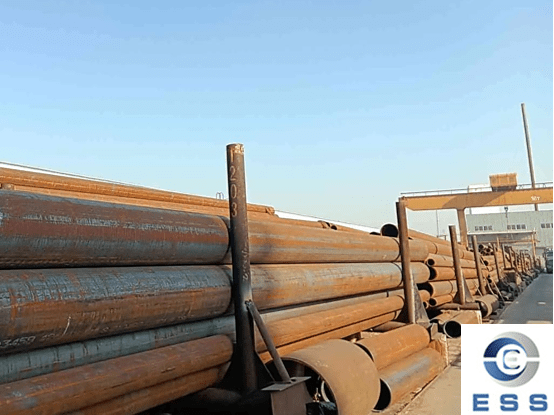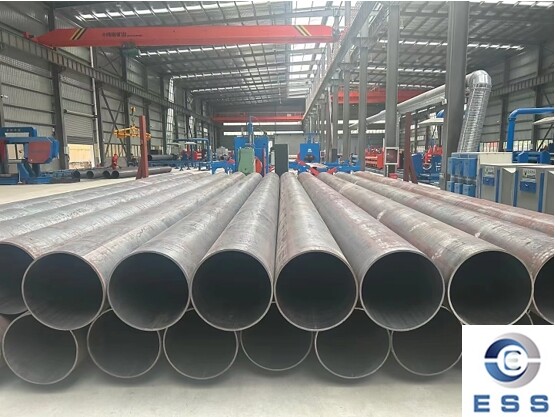Boiler
tube refers to steel with openings at both ends and hollow sections, and
the length is relatively large compared to the surrounding area. According to
the production method, they can be divided into seamless
steel pipe and welded
steel pipes. Boiler tubes are key components for conveying high-temperature
and high-pressure fluids, and their welding quality is directly related to the
safety and reliability of the equipment. So how to weld boiler tubes?

Welding wire for boiler tube welding
When choosing welding wire for boiler pipe
welding, it is necessary to select suitable welding wire according to the
material, strength and other characteristics of the welding material. Commonly
used welding wires include ER50-6, ER70S-6 and ER80S-G.
1. ER50-6 welding wire
ER50-6 welding wire is a carbon steel
welding wire, the main components of which are carbon, manganese, silicon,
etc., with good fluidity and crack resistance. It is suitable for welding
ordinary carbon steel, low alloy steel and other materials.
2. ER70S-6 welding wire
ER70S-6 welding wire is also a carbon steel
welding wire, but it contains higher manganese, silicon, vanadium and other
elements. It has good welding performance and mechanical properties and is
suitable for welding various structural steels.
3. ER80S-G welding wire
ER80S-G welding wire is a low alloy steel
welding wire, the main components of which are chromium, molybdenum, manganese,
etc. It has excellent corrosion resistance and is suitable for welding high
strength and high corrosion resistance materials.
Welding rods for boiler tube welding
Boiler tubes are generally made of carbon
steel or alloy steel. The following welding rods are commonly used for welding:
1. Carbon steel welding rod: suitable for
welding of general carbon steel boiler tubes, such as E6010, E6011, E6013,
E7018, etc.
2. Low alloy steel welding rod: suitable
for welding steel containing alloy elements, such as E8016-B2, E8018-B2, etc.
3. Stainless steel welding rod: suitable
for welding of stainless steel boiler tubes, such as E308, E309, E316, etc.
Welding methods for boiler tubes
1. Manual arc welding
Manual arc welding is the most common and
simplest welding method, suitable for welding small workpieces. The method is
to use an arc to melt the welding material (welding wire) and the two ends of
the workpiece, and achieve the welding purpose through fusion and cooling
solidification.
2. Gas shielded welding
The welding material of gas shielded
welding is welding wire. Its advantages are that it improves the welding speed
and quality, while reducing the generation of oxidation and welding slag, which
can be applied to the welding of boiler tubes.
3. Submerged arc welding
Submerged arc welding is a method of
placing the welding rod in the weld position, burying it under the welding
part, and then heating it with a melting arc to melt the welding rod and the
workpiece to achieve welding.
Welding methods for boiler tubes of different materials
1. Carbon steel boiler tube
Carbon steel boiler tubes are welded with E7018 welding rods and DC welding. The welding process requires strict requirements, and factors such as welding temperature, welding speed, and number of welding layers need to be well controlled.
2. Alloy steel boiler tube
Alloy steel boiler tubes are welded with special welding machines and special welding materials. Welding materials should be selected with low hydrogen content electrodes containing elements such as chromium, molybdenum, and tungsten.
3. Stainless steel boiler tube
Stainless steel boiler tubes are welded by argon arc welding. Welding rods with low hydrogen content and high purity are selected. The welding temperature and annealing temperature must be strictly controlled during welding to ensure welding quality.

Welding process of boiler tubes
In the welding of boiler tubes, the
characteristics of the tubes should be fully understood, and appropriate
welding methods should be selected according to the different materials.
Usually, when selecting welding materials, it is necessary to comprehensively
consider factors such as the strength, ductility, and corrosion resistance of
the materials to ensure the welding quality.
During the welding process, attention
should also be paid to the control of parameters such as welding temperature,
current, and time, as well as the cleaning and polishing of the weld to ensure
the welding quality.
Steps of boiler tube welding process
1. Preparation before welding
Clean the welding area to ensure that the channel is unobstructed to avoid blockage during welding; at the same time, heat the welding materials to reduce welding deformation.
2. Welding operation
Perform welding operation by selecting appropriate welding process and welding equipment.
3. Post-weld treatment
After welding, the weld needs to be polished, cleaned and inspected to ensure welding quality and sealing.
Precautions and skills for boiler tube welding process
1. Clean the welding area before welding to avoid contamination and defects during welding.
2. Control the welding current, voltage and welding speed during welding to ensure welding quality and tightness.
3. Heat the welding materials during welding to reduce welding deformation.
4. After welding, the weld needs to be polished and cleaned to achieve a smooth and smooth effect and ensure welding quality.
5. It is necessary to select appropriate welding process and welding equipment according to the thickness of the boiler tube wall and the welding position. At the same time, it is also necessary to select suitable welding materials and electrodes.
Summary
In short, when choosing welding wire for
boiler tube welding, you should choose the appropriate welding wire according
to the actual situation, and when choosing welding rods, you need to choose
according to the specific materials and welding requirements to ensure the
welding quality and connection strength. At the same time, you should pay
attention to the welding parameters and temperature control during the welding
process to ensure the welding quality.
Read more: Material of Boiler tube or Key Points of Boiler Tube Welding Process













 Eastern Steel Manufacturing Co.,Ltd not only improve product production and sales services, but also provide additional value-added services. As long as you need, we can complete your specific needs together.
Eastern Steel Manufacturing Co.,Ltd not only improve product production and sales services, but also provide additional value-added services. As long as you need, we can complete your specific needs together.











